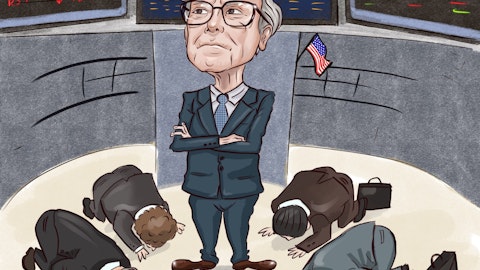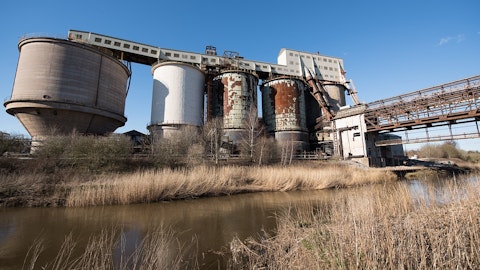Celanese Corporation (NYSE:CE) Q3 2023 Earnings Call Transcript November 7, 2023
Operator: Hello, and welcome to the Celanese Q3 2023 Earnings Call and Webcast. [Operator Instructions] As a reminder, this conference is being recorded. It is now my pleasure to turn the call over to Brandon Ayache, Investor Relations. Please go ahead.
Brandon Ayache: Thanks, Kevin. Welcome to the Celanese Corporation Third Quarter 2023 Earnings Conference Call. My name is Brandon Ayache, Vice President of Investor Relations. And with me today on the call are Lori Ryerkerk, Chairman of the Board and Chief Executive Officer; and Scott Richardson, Chief Financial Officer. Celanese distributed its third quarter earnings release via Business Wire and posted prepared comments on our Investor Relations website yesterday afternoon. As a reminder, we will discuss non-GAAP financial measures today. You can find definitions of these measures as well as reconciliations to the comparable GAAP measures on our website. Today’s presentation will also include forward-looking statements.
Please review the cautionary language regarding forward-looking statements, which can be found at the end of both the press release as well as the prepared comments. Form 8-K reports containing all of these materials have also been submitted to the SEC. Before opening it up for your questions, let me turn it over to Lori to provide a few introductory comments.

Lori Ryerkerk: Thanks, Brandon. So we have done and announced a lot recently. So I just wanted to take a minute or two to emphasize again exactly what we are all working so hard to achieve at Celanese. I can confidently say that at no point in our history, has there been a greater opportunity for Celanese to deliver significant earnings growth as in the next few years. In the Acetyl Chain, we continue to enhance our earnings power and optionality with projects like the acetic acid expansion at Clear Lake, and the methanol expansion also at Clear Lake which will dramatically strengthen our sustainable product offerings. Of course, in Engineering Materials, we continue to integrate and synergize the M&M acquisition, which transforms EM into the preeminent global specialty materials provider.
This important and valuable work has been made more challenging in the demand backdrop that remains exceptionally weak and volatile. Our visibility into future macro conditions is limited. Regardless, our teams have worked tremendously hard to deliver three consecutive quarters of earnings growth since closing the M&M acquisition and to position us to meaningfully exceed our full-year objective to reduce net debt by $1 billion in 2023. The work has not been easy, and I sincerely thank each of our employees for their individual contributions and dedication. Quite frankly, while the work is moving forward at pace, the macro environment has temporarily masked some of the underlying financial benefit of our actions to strengthen our business. But we remain resolute in continuing to take decisive and controllable actions.
Our most recent actions, including the announced changes to our leadership team and manufacturing footprint, are evidence of our ongoing commitment to drive earnings growth and execute against our delevering plan. The purpose behind the changes I have made in our executive leadership team is to enhance the alignment of our individual strengths and experience to accelerate and deliver on the many value-enhancing opportunities before us. Scott, Chuck and Ashley are exceptionally well prepared for their new roles, and I am confident these changes will immediately enhance the value we drive as a collective leadership team. I speak for our leadership team and broader Celanese in saying we are fully engaged and committed to delivering on the opportunities before us.
With that, Kevin, let me turn it back over to you to open it up for questions.
See also 20 Best Online Jewelry Stores In the World and 20 Richest Arab Billionaires In The World.
Q&A Session
Follow Celanese Corp (NYSE:CE)
Follow Celanese Corp (NYSE:CE)
Operator: [Operator Instructions] Our first question is coming from Mike Leithead from Barclays. Your line is now live.
Michael Leithead: Great. And congrats to Scott, Chuck and Ashley on the new roles. Laurie, I wanted to start on Engineered Materials pricing. I think in the prepared remarks, you made a comment that pressure has widened throughout the year, but nothing indicates that structural. So can you maybe just talk a bit more about your confidence here or maybe what you have seen in previous down cycles versus now? Just what gives you the confidence in making that comment?
Lori Ryerkerk: Yes. If I think about pricing, and again, I’ll split it into two. What we have really seen is pretty good price stability and differentiated products. What we have seen them is more of the volume impact there associated with consumer able consumer electronics, there, we have just seen a pretty significant volume decline as we have seen consumer demand come off this year as people have shifted their spending to more services and experiences. Where we have really seen the price pressure is for more standard grade materials where we are seeing quite a bit of length in the industry in terms of supply, softer demand and everyone having to take price action to come down. What I would say is one of the reasons we are taking the steps that we have announced around [indiscernible] is really to better position our supply with the current demand scenario by shutting down some of our higher cost operating capacity filling those customer needs with lower cost capacity we already have or even purchases, if that is lower.
And then in the future, as we see demand start to come back to what I would consider a more normalized level, we should be able to provide that demand from other assets that we already have in our network and through no and low-cost debottlenecks. So I think we are in a kind of unique position structurally with very little exports out of China. A very soft, soft environment in Europe and feel confident in time, it will come up. I mean, auto is a great example. Auto has been very solid this year. We expect that to continue. Medical has been solid. So I think we really are just seeing a reflection of consumer preference and consumer spending, which we believe is temporary and off the highs that we saw in 2021.
Michael Leithead: And then a question for Scott, maybe on free cash flow. I think in Lori’s 2024 outlook she laid out in the prepared remarks, maybe $300 million or $400 million of earnings improvement next year you guys are probably getting a similar type of amount of working capital benefit this year. So as we think about free cash generation next year, is relatively flat year-on-year, a good starting point today or is there further working capital or other cash benefits you think you can get next year?
Scott Richardson: Yes. Thanks, Mike. We are going to work to ensure that as we see earnings growth that we put that as much to the bottom line of free cash flow as possible. We called out CapEx being $100 million lighter next year as well. I think the variable will be working capital. And it depends upon kind of what happens with raw material pricing as well as depending on kind of where sales are what happens with the accounts receivable line. But we are going to do everything we can to continue to bring inventory down next year. There could be an opportunity for further reduction depending on what happens with demand as well as in the raw material landscape.
Operator: Next question is coming from Jeff Zekauskas from JPMorgan. Your line is now live.
Jeffrey Zekauskas: I think Eastman’s filter tow profits are up I don’t know, $225 million through the nine-months. There was no mention of filter to in your remarks. How is that business doing? And how is it affecting the acetal chain earnings?
Lori Ryerkerk: Jeff, as you know, we are running that as an end-to-end chain now. We are treating to as we do other downstream derivatives. What I would say is we are seeing similar impacts in tow. Now we are seeing in the second half a reset of contract pricing, which is bringing those margins down slightly from the first half, but that was anticipated with the way the contracts are set up. But I would say we are still on track to exceed the $245 million that we set out earlier this year target for sale.
Jeffrey Zekauskas: You are closing your German nylon facility. Is that about 15% of your nameplate capacity in nylon? And what utilization rate are you running at in nylon generally?
Lori Ryerkerk: Yes. So [Untrip] (Ph) actually is one of the four plants that we have for nylon and it represents right at 25% of our total capacity. I don’t have the overall total utilization numbers in front of us. But I would characterize this, Jeff, as much like we have done with Palm and other assets where we have really worked on concentrating our footprint taking out either underutilized or less profitable assets in order to shift volume into lower cost, more profitable assets, getting more flexibility in our networks in terms of purchasing either of polymer or different raw materials, depending on where we produce, that is what we are trying to be able to hear with the intro shutdown is we knew going into the deal that we believe DuPont had excess capacity.
Now that we have had some time to look at it, we believe shutting down the Introp is the best way to really adjust our cost basis on nylon while still maintaining compounding in Europe, which is necessary for our customers. But I would say this is very consistent with what you have seen us done over the last 10 or so years in Celanese where we have probably shut down over 15 facilities in the last 10-years as we have implemented these models.
Operator: Next question is coming from Mike Sison from Wells Fargo. Your line is now live.
Michael Sison: You haven’t told I need to do more math these days. So if I add up sort of your bridges that you gave for 2024 and just use the lower end of the inventory stuff. It looks like a no volume growth, you could do $12 or better. Is that the right math? And then can you help us on what or how to frame up volume and inflation or deflation upside for 2024?
Lori Ryerkerk: Yes, Mike, we laid out the various buckets. So I think you can do the math. I mean, just to reiterate, we do expect to get more than $150 million in additional M&M synergy. With some of the acceleration of the manufacturing footprint optimization. Hopefully, we can exceed that amount as well since we didn’t have all of that baked in. We should get another $100 million once we get clear like acetic acid started up. . Debt service goes down by about $50 million. We will have less inventory reduction next year, so less margin impact from that. And then I think, as you are saying, the big issue there is really going to be what is the benefit we see for flushing through higher cost inventory. And this could be a very big number.
It will depend on what happens with raws. As you know, we are in quite a volatile raw material environment right now. And then what happens with demand going forward. If demand stays low, then I think these are the things we are focused on because these are what we can control. if demand goes up, obviously, we will get more margin, but we will also probably see some increase again in working capital. So I would just say there is still a lot of volatility and uncertainty around next year, and that is why we are just really focusing on those big buckets that we outlined that are in our control.



